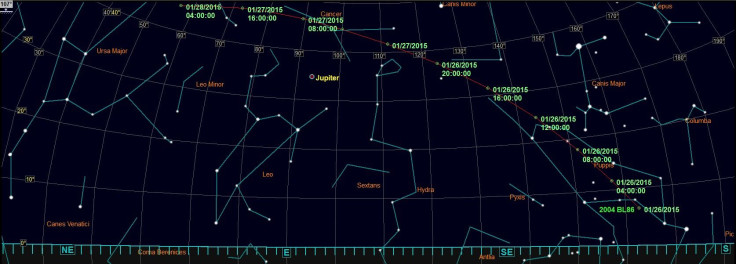Asteroid 2004 BL86 Close Approach Live Stream: Watch It Pass 745,000 Miles From Earth, Viewing Tips

Asteroid 2004 BL86 will pass incredibly close, around 745,000 miles, to Earth and stargazers can watch the close approach with the aid of binoculars or a telescope while Slooh will team up for a live stream. The asteroid is a third of a mile in size and will not pass so close to Earth for another 200 years. The asteroid's close approach live stream begins at 11 a.m. EST Monday.
"The close approach of 2004 BL86 will provide a great opportunity for astronomers to observe a large asteroid up close and personal; the radar images, in particular, should be just amazing. Since we've been tracking the asteroid for 11 years, we know its orbit really well, and we know it will not approach our planet this close again for at least a couple centuries. This is a rare opportunity for some great science!," Dr. Paul Chodas, manager of NASA's Jet Propulsion Laboratory’s Near-Earth Object Program Office, said in a statement.

Asteroid 2004 BL86 will be traveling fast in the night sky but viewers in North and South America, Europe and Africa will have a good vantage point, according to Sky and Telescope.
On Monday, stargazers should look up and find the constellations of Hydra and Cancer. The space rock will be traveling northward through the night and will appear just north of Hydra around 7 p.m. EST. It will pass through the center of Cancer, and the Beehive Cluster, an open cluster of stars that is visible to the naked eye, around 1 a.m. EST Tuesday.
Sky and Telescope suggests to find a star along its charted path to better track and observe the asteroid move in real-time. EarthSky has more ways to track the asteroid, which is traveling at 35,057 miles an hour, using a telescope or with strong binoculars.

Slooh and NASA will provide an asteroid close-approach livestream beginning at 11 a.m. EST. The asteroid will make its closest approach to the planet at 11:20 a.m. EST. The team will have views of the asteroid from Australia and Chodas will be joined by Slooh astronomer Bob Berman and Dr. Lance Benner, NASA Research Scientist, to discuss the asteroid and Near-Earth asteroids.
"NEA 2004 BL86 is an eye-opening reminder of the potential risks of asteroid impacts and the importance of acquiring and tracking asteroid orbits. It is estimated that while 90 percent of the kilometer plus sized asteroids have been discovered, only 30% of the 140 meter-sized NEAs have been found, with less than 1 percent of the 30-meter sized NEAs having been detected," Slooh said in a statement.
The asteroid live stream can be viewed below.
© Copyright IBTimes 2024. All rights reserved.












